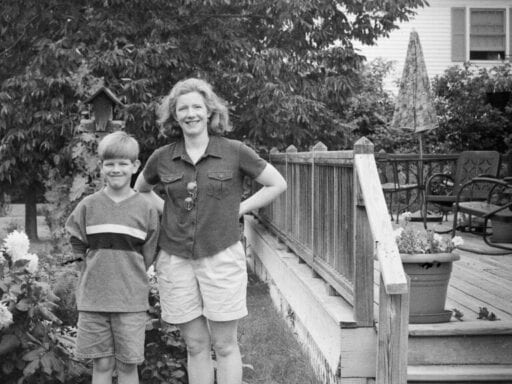Vox is investigating addiction treatment in America. Here’s our first story.
SOUTH BURLINGTON, Vermont — Kim Blake keeps a folder in her house, swollen with papers. Each document represents yet another try at helping her son Sean recover from a decade of drug addiction.
Some papers are certificates of graduation from rehab, one telling Sean that “you are no longer alone.” Some are letters by Sean marking his progress, going back to his late teens, writing about getting better.
And there are many, many bills. I verified the bills and that the Blakes paid for them. The total cost: $110,000.
That’s the minimum that Kim and her husband Tim, Sean’s dad, estimated they spent on addiction treatment. The Blakes said they also spent thousands on other treatments that they no longer have bills or receipts for. (Their insurance provider made additional payments, as well.)
Through it all, the Blakes drained their savings for retirement, along with college funds for both Sean and his younger brother.
Kim told me, through tears, that there was one outcome that would have made it all worth it: “If he had survived, we would have said it was money well spent. There’s no question.”
But none of the treatments stuck. In August 2017, Sean died of a drug overdose involving alcohol and fentanyl, a synthetic opioid. He was 27 years old.
/cdn.vox-cdn.com/uploads/chorus_asset/file/19127287/voxmedia_blakefamily_072419_6951.jpg) Ben DeFlorio for Vox
Ben DeFlorio for VoxSean was one of the hundreds of thousands of victims of an opioid epidemic that began in the 1990s. His death was part of a grim milestone: the deadliest year on record in America for drug overdoses, with more than 70,000 people dying to drug overdoses in 2017 alone. Families are desperate to avoid this fate. Over the past few months, I’ve spoken with many who have their own tragic stories of losing a loved one to addiction. Each of them has spent tens of thousands, if not hundreds of thousands, on addiction treatment.
In story after story, the same experience was repeated over and over: of patients and families getting sucked into an American rehab industry that is largely unregulated, shockingly ineffective, and ruinously expensive.
Vox is launching an investigation into the notoriously opaque addiction rehab industry, called The Rehab Racket. We’re crowdsourcing the experiences of patients and families, with an emphasis on cost and quality of care. If you have a story you’d like to share with us, please visit our submissions page.
Addiction treatment is difficult work, but it can succeed, and evidence-based care does exist. For opioid addiction in particular, studies show medications like methadone and buprenorphine cut the death rate among patients by half or more.
But the parents I spoke to have learned — as thousands of Americans discover each year — that much of the US rehab industry does not provide evidence-based, effective care.
American rehab is dominated by a 12-step approach, modeled after Alcoholics Anonymous, that only works for some patients and doesn’t have strong evidence of effectiveness outside of alcohol addiction treatment.
That’s often coupled with approaches that have even less evidence behind them. There’s wilderness therapy, focused largely on outdoor activities. There’s equine therapy, in which people are supposed to connect with horses. There’s a confrontational approach, which is built around punishments and “tough love.” The research for all these is weak at best — and with the confrontational approach, the evidence suggests it can even make things worse.
“It is a scam,” Carol Beyer, a New Jersey mother who estimated that she spent well over $100,000 on treatment — including 12-step and “tough love” programs — and still lost her two sons to drug overdoses, told me.
Sean Blake’s journey, as described by his mother Kim, took him through rehab more than a dozen times in facilities that were generally well-intentioned but often overwhelmed and ineffective. He didn’t usually get medications for opioid addiction. His underlying bipolar disorder went undiagnosed and untreated until late in his life. After Sean got out of residential treatment, there was often no or little adequate follow-up.
I contacted all of the facilities that his family said he attended. Except for one doctor, representatives either didn’t respond or declined to comment citing privacy reasons.
“We can’t discuss specific clients or cases,” Konstantin von Krusenstiern, vice president of development and communications at Brattleboro, one of the last places Sean attended, told me.
/cdn.vox-cdn.com/uploads/chorus_asset/file/19127404/jhsgrad.jpg) Courtesy of Kim Blake
Courtesy of Kim Blake/cdn.vox-cdn.com/uploads/chorus_asset/file/19127406/voxmedia_blakefamily_072419_7058.jpg) Ben DeFlorio for Vox
Ben DeFlorio for Vox“I do love being sober,” Sean wrote to his mom during one of his stints at rehab. “It’s life that gets in the way.”
Two years after Sean’s death, the stack of papers in Kim’s folder continues to impact his parents’ lives. Their suburban house — two stories and with a modest lawn — needs a new coat of paint, and some parts have languished in disrepair, Tim said. But the Blakes assured me that it would have all been worth it if Sean was still alive.
“Just the weight of the loss is, to me, the biggest thing,” Tim said. “The financial cost is kind of inconsequential to me at this point.”
Desperate for answers
Sitting in the Blakes’ living room, it was impossible to avoid the absence of Sean. Photos of him alongside his brother and parents, with his wavy blond hair and wide smile, adorned the walls. Relics and artifacts from when he was alive — drawings, paintings, poems, essays — were scattered around the house.
Kim didn’t hesitate to brag about her son’s charm and intelligence. When Sean was young, the Blakes would go on vacations to New York City, and struggle through the maze of New York’s public transportation system.
But Sean had no trouble. “You said, ‘Well, we’re here, and we want to go here.’ And he’s like, ‘Well, we have to take the F train to so-and-so, and then we switch,’” Kim said. “He was a pretty bright kid.”
Sean began to have problems with alcohol and marijuana in high school, and his parents sent him to outpatient addiction treatment twice. They hoped the two treatments would take care of the addiction problems for good.
In the fall of 2009, after he graduated high school, Sean decided to join the Navy and become a cook. But he did so well on an admissions review that the Navy said he should instead be a submarine electrician, a higher-skilled position.
/cdn.vox-cdn.com/uploads/chorus_asset/file/19127453/lboston.jpg) Courtesy of Kim Blake
Courtesy of Kim BlakeSean did well in the Navy for a few months. But once he advanced in the training program, and got more freedom and cash, he again began using drugs, including alcohol, marijuana, cocaine, and opioids.
The problem came to the forefront as Sean visited from the Navy on Easter weekend 2010, about five months after he enlisted. The family sat down for brunch — and Sean took off on his bike to buy drugs. “We were like, ‘What the heck happened? Two weeks ago you were doing great,’” Kim said.
Three months after that, Sean, by then 20 years old, was discharged from the Navy. He had by then started using heroin. He also started to steal from his own family, including his little brother’s video games, to get money to buy drugs.
So they gave him an ultimatum: get into treatment, or move out. He moved out for a bit — but ultimately came back to agree to treatment in October 2010.
That could have been the turning point. But it wasn’t. “That was the beginning of this period of cycling through rehab after rehab after rehab,” Tim said.
The Blakes wanted to get Sean in a residential program. But in 2010 in Vermont, and most of the US today, addiction treatment was hard to access. The Blakes found a prominent facility that took Sean quickly: the Hazelden Betty Ford youth program in Minnesota, which focused on a 12-step approach and didn’t offer opioid addiction medications at the time. It cost more than $36,000 in total for a five-week stay, but it was the best, the family thought, they could get Sean into.
Their employer-provided health plan, with Blue Cross and Blue Shield, eventually agreed to pay for around $28,000 after various appeals, leaving the Blakes down more than $8,000, based on bills and receipts provided by the family.
The Blakes said insurance coverage was spotty. Blue Cross and Blue Shield didn’t always agree to pay for care, and it could require appeals to do so. When insurance did pay, the Blakes had to overcome a $5,000 annual deductible and 20 percent coinsurance. (A spokesperson said Blue Cross and Blue Shield can’t discuss individual patients or if they were even enrolled in a plan with the company.)
Over the next decade, the Blakes sent Sean to more than a dozen rounds of rehab, spending tens of thousands of dollars, in hopes something might finally cure him. It was “10 years of struggling — our entire family, everyone just trying their best,” Kim said.
/cdn.vox-cdn.com/uploads/chorus_asset/file/19127459/rHelpwanted_brighten.jpg) Courtesy of Kim Blake
Courtesy of Kim BlakeThrough it all, Sean was well aware of what he was going through. “I need a God in my life,” he once wrote. “The only thing I want from this God, right now, is to lead me to sanity. As time goes on, I may want God to help me forgive myself, give me the courage to do the right thing, and shape me into a better man. Right now, I need God to bring me out of the chaos.”
The journey would eventually drain the money the Blakes had stored in a savings account for retirement and their kids’ college funds. As a result, Sean’s younger brother had to take $40,000 in student loans to get through college. Ned, Sean’s brother, said “it hurts” that he had to get into debt, but agreed with his parents that it pales in comparison to losing Sean.
Brendan Saloner, a health policy researcher at Johns Hopkins University, said this is typical — that “desperation” drives family members to seek out treatment after treatment, trying to find something that works.
“We have allowed this system to evolve so that there’s a lot of great treatment out there that people don’t know about, and a lot of predatory treatment that will basically rob you blind,” Saloner said. And parents and other family members, he added, frequently don’t know what they’re getting into.
The rehab cycle
The problems with addiction treatment create what experts describe as a vicious cycle: Desperate for some sort of cure, people get into the first addiction treatment they can, paying whatever is necessary. But then the treatment often doesn’t stick, or there’s no serious follow-up once a patient gets out, and eventually there’s a relapse. So the patients or their family members seek another treatment, and the process begins anew. For some families, this can repeat a dozen or more times — and in the end, the person struggling with addiction still may die or continue to suffer.
A big issue is there’s simply no way for most people to know if a treatment is good in the first place. There’s no Yelp for rehab. Insurers do a bad job communicating which programs work. Accreditors, industry groups, and other regulators do very little to verify the quality of care.
The Centers for Medicare and Medicaid Services “has over 4,000 quality measures,” Tami Mark, a health economist at the research foundation RTI International, told me. “There are none for addiction programs — zero.”
The Blakes went through this cycle again and again.
After five weeks at the Hazelden Betty Ford program, Sean got into a fight over something minor, and got kicked out in November 2010. Tim speculates now that this was deliberate on Sean’s part because he wanted to get moved to a place that, unlike the Hazelden Betty Ford program at the time, would let him smoke.
Sean then went to New Found Life, another rehab facility based on the 12 steps, in Long Beach, California. In New Found Life, Sean seemed to do better at first. “He really turned it around there, I think,” Kim said.
But within a few months, Sean would be homeless and using drugs in Los Angeles — and within six years, he would die of a drug overdose.
In those six years, Sean also went to Cornerstone in Tustin, California; Little Creek Lodge in Hamlin, Pennsylvania; the Howard Center in Burlington, Vermont; the Maple Leaf Treatment Center in Underhill, Vermont; Brattleboro Retreat in Brattleboro, Vermont; and Valley Vista in Bradford, Vermont. In a few cases, Sean returned to these facilities multiple times.
Each of the treatments could range between the hundreds to tens of thousands of dollars, according to bills that the family provided. Over about a year, New Found Life cost more than $52,000. Little Creek Lodge, which is a wilderness program, cost more than $20,000. There were also sober houses, with their own extra costs, sprinkled in-between.
Some of the places Sean went to are still respected and, according to experts in the field, do use evidence-based models of care. Even in the best facilities, addiction can be very difficult to treat — with many ups and downs, and success not always guaranteed. Sean himself presented problems, Kim said, because he was in denial about his opioid addiction for much of his life (in large part, she suggested, because opioid addiction was especially stigmatized in the 12-step programs he repeatedly attended).
But many of the treatment facilities Sean went to were deeply flawed. One facility, the Maple Leaf Treatment Center in Vermont, shut down in 2017 due to complaints, a lack of licensed drug addiction counselors, and an investigation that found the center overbilled Medicaid by $860,000.
John Kelly, an addiction treatment expert at Harvard, told me treatment can take several times over several years to stick. What’s unclear is if this is mostly an inherent problem with drug use disorders — which are, after all, chronic, relapsing conditions — or really caused by America’s woefully inadequate addiction treatment system, which frequently rejects, for example, proven medications for opioid addiction treatment.
“The problem in the industry isn’t that we have a few bad actors,” Mark, the health economist, said. “It’s that a large portion of the addiction industry isn’t providing the type of care that we know leads to recovery.”
Ineffective help
Kim, who’s now an addiction treatment provider herself, is careful to acknowledge that her family and Sean made some mistakes. But there were also problems, she argued, with how the rehab system treated Sean.
For one, the majority of treatment centers Sean went to were based around the 12 steps, popularized by Alcoholics Anonymous and Narcotics Anonymous. The research shows that 12-step treatment is effective for some people with alcohol addiction, but the evidence is much weaker for other drugs, and many people with drug addictions don’t do well under a 12-step regimen. Although many of these programs purport to treat addiction as a medical condition, they often take a moralizing view toward addiction — one that feeds into stigma.
Yet 12-step programs were the only thing the Blakes could find for much of Sean’s life, and they’re the basis for the bulk of addiction treatment in the US.
The treatment facilities also generally didn’t offer medications that are considered the gold standard for opioid addiction: buprenorphine, methadone, and naltrexone. While Sean did struggle with other drugs, opioids were at the center of his drug use for much of his life.
Outside a few bouts of naltrexone (likely the least effective of the three options), Sean had a hard time getting and staying on the medications, because some of the treatment facilities didn’t offer them, or they actively discouraged them based on the moralizing, stigmatizing view that using medications is “replacing one drug with another.”
John Brooklyn, an addiction doctor at Vermont’s Howard Center, occasionally saw Sean in the last few years of his life. Brooklyn said that stigma against medications, perpetuated by treatment programs and 12-step meetings, likely made it harder for Sean to even accept treatments that could have helped. “He thought that he should be able to do it on his own,” despite Brooklyn’s recommendation Sean get on buprenorphine or methadone, Brooklyn told me. “I’m emphasizing thought and should.”
/cdn.vox-cdn.com/uploads/chorus_asset/file/19127549/seanprofile.jpg) Courtesy of Kim Blake
Courtesy of Kim BlakeFinally, many treatment facilities failed to catch and treat Sean’s other mental health issues — including bipolar disorder, leaving it untreated until it was finally diagnosed a few years before Sean died. Kim also speculates that Sean had PTSD by the end of his life, based on some of his erratic behaviors. This likely worsened his addiction: If Sean was using drugs to self-medicate and calm his mind, not treating underlying disorders and only going after his addiction with 12-step treatment was somewhat like trying to heal a gunshot wound with a bandaid.
One facility, though, was an exception: the Rikers Island jail in New York City.
In 2012, after struggling in rehab after rehab, Sean went to New York. For months, his family didn’t hear from him. Sean spent this time stealing to get money for drugs, sometimes even at the expense of food. “‘You are what you eat’ and I haven’t eaten anything in a day or two, except drugs,” Sean wrote in a retrospective essay. The crimes eventually landed him in the Rikers Island jail, where he contacted his parents.
Rikers is a terrible place — that’s why the city is shutting it down — and prisons and jails in general do an awful job with health care, especially addiction treatment. But it was in Rikers that Sean was first told that he likely had bipolar disorder and began receiving treatment for it. And it was there where he was started on methadone for his opioid addiction. (Rikers is an exception; in later stints in Vermont jails, Sean was cut off from psychiatric medications.)
Before he got out of Rikers, Sean would be weaned off methadone, a potentially lifesaving medication, because back home in Vermont, the local methadone clinics at the time were inaccessible — with waiting periods extending months or even years. Soon after his release, Sean would again relapse, going back to the cycles of rehabs and jail.
For the Blakes, each of these failures represented not just more heartbreak, but also more financial costs. As Kim told me, “My husband and I definitely changed our retirement plans. We are both working longer than expected.”
The Blakes at least had the savings to shoulder the costs, with their incomes as a doctor and teacher. But they wonder what they would have done without those savings. People dealing with addiction who don’t have money stashed away, Tim said, “must really struggle to make ends meet.” Kim pointed out that it’s not uncommon for people to go into debt to pay for care.
It’s representative of the vicious cycle: If Sean had obtained good treatment from the start, perhaps offering medications for opioid addiction and treating co-occurring mental health conditions, it could have been the end of all the rehabs. But the Blakes had to shoulder the cost of inadequate rehab after rehab — until Sean died.
Finding a better way
Addiction treatment can succeed. I’ve seen it in my own work time and time again: When people’s needs are met where they are, when evidence-based practices are followed, and when treatment is quickly accessible, people with years- or even decades-long addictions can get better.
Some of this work is now happening in Vermont. Since 2012, John Brooklyn, previously one of Sean’s doctors, has helped the state build a “hub and spoke” system that has, by linking existing treatment options with the rest of the health care system, dramatically increased access to evidence-based addiction treatment across the state. Charlie C., a patient in the system, told me, “It saved my life. I believe that, 100 percent.” When I last checked on Charlie, he was holding down a job and went on a vacation in Kenya for a friend’s wedding.
Perhaps it could have helped Sean, too. The same methadone clinic that had a years-long waiting period when Sean got out of Rikers in 2012 can now see new patients within, at most, days. But those access improvements only came to fruition in 2016 and on.
The reality, though, is in most of the US outside Vermont, addiction patients still often face the problems that Sean did. According to the surgeon general, just one in 10 people with a drug addiction gets specialty treatment. And the majority of treatment facilities don’t offer proven medications for opioid addiction.
One problem is that much of the treatment industry still follows what experts call an acute model of care, suggesting that you can ship people with drug addictions to a rehab facility for 28 days and they’ll come out cured — with little to no follow-up necessary, besides AA or NA meetings. The Blakes, too, bought into this, Tim said: “We thought, ‘Well, all is well. You send them off to rehab, they’re cured, and that’s the end of it.”
But addiction is a chronic, relapsing condition. Just like we don’t expect diabetes to be treated by one stint at a hospital or a single insulin shot, addiction requires long-term care. In fact, experts argue, proper care may not even require inpatient or residential treatments at all; as long as it’s long-term, outpatient is likely enough in most cases of drug addiction.
“The science is very clear on what works,” Mark, the health economist, said. “You have to keep people in care for a long enough period of time. And it’s not happening — and it ends up wasting billions of dollars.”
To solve these problems, experts say that a large investment is needed into addiction treatment across the US — focused not just on scaling up access, but making sure that treatments are centered around evidence-based care, meet higher quality standards, and rigorously track outcomes for patients.
For her part, Kim is now on the front lines of Vermont’s efforts. Now that the state has built up its hub and spoke system, it’s testing options to lower the barriers to care even further. Kim works at one such place, prescribing buprenorphine, the opioid addiction medication, for patients at a needle exchange, known as the Safe Recovery Program.
/cdn.vox-cdn.com/uploads/chorus_asset/file/19127565/voxmedia_blakefamily_072419_7163.jpg) Ben DeFlorio for Vox
Ben DeFlorio for VoxKim and the needle exchange’s staff showed me around the program — talking about the thousands of people served, and pointing to the stacks of syringes, the materials that help link people to other treatment, and a poster claiming more than 1,000 overdoses had been reversed by naloxone, the opioid overdose antidote, distributed by the facility.
Kim guided me to her office, where patients can get started on addiction treatment the day they show up — at little to no cost, depending on insurance coverage.
When I asked how Sean would have done if the program had been available for him, Kim didn’t hesitate: “I think he might still be alive.”
We want to hear from you
Please help our reporting by sharing your story with us. You can also sign up for our email newsletter to get updates on the project.
Author: German Lopez
Read More



